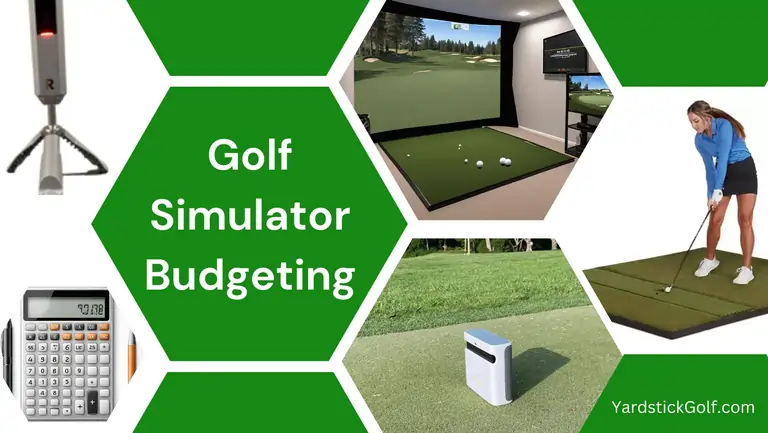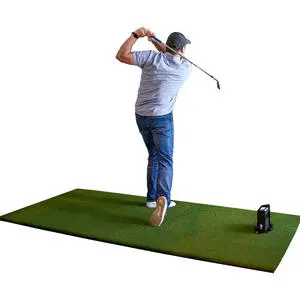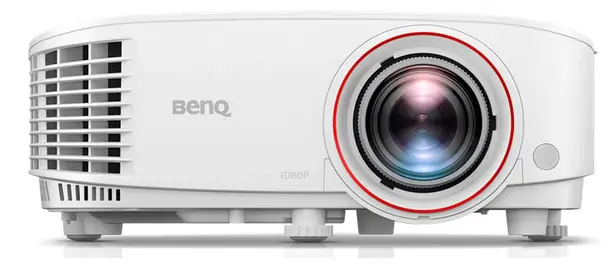Golf Simulator Budgeting: Maximize Your Investment

Are you an avid golfer looking to improve your game without leaving the comfort of your home? A golf simulator might be the perfect solution for you. However, before diving into the world of golf simulators, it's important to understand the costs involved and how to make the most of your investment. In this comprehensive guide, we'll break down the essential components, discuss modifications to your space, explore optional accessories and add-ons, weigh the pros and cons of buying at once or over time, delve into upgradability and future enhancements, and provide budgeting tips and recommendations to help you create your dream golf simulator setup.
Understanding the Costs Involved
Setting up a home golf simulator setup requires several essential components that contribute to the overall cost. Let's take a closer look at each of these components, which are integral to creating an immersive indoor golf simulator experience.
Launch Monitors

The launch monitor is the brain of a golf simulator, providing crucial data about your swings and shots. Basic launch monitors track the club face's path through impact, while more advanced ones calculate the entire flight of the ball. The price range for launch monitors can vary significantly, from affordable options starting at around $499 to high-end models costing up to $14,000. Consider your budget and desired level of accuracy when choosing a launch monitor, and don't forget to include compatible golf simulator software in your setup.
Simulation Software
To recreate the experience of playing golf on a virtual course, you'll need golf simulator software . This software uses data from the launch monitor to generate realistic ball flight and course visuals. Prices for golf simulation software can range from free options with limited features to premium packages that cost several hundred dollars.
Hitting Mats

A quality golf hitting mat is essential for practicing your swings and shots, especially if you're looking for a cheap indoor golf simulator solution. The cost of hitting mats can vary depending on the size and durability. Budget-friendly options can start at around $150, while high-end mats can cost up to $4,000. Consider factors such as the quality level and surface area required when selecting a hitting mat.
Projectors

To display the virtual golf course on a large screen or impact screen, you'll need a golf simulator projector . Projector prices typically range from $699 to $1,500. Consider factors such as resolution, brightness, and throw distance when choosing a projector that suits your needs and budget.
Impact Screens and Enclosures
An impact screen is crucial for capturing and displaying the ball's trajectory after impact, and it's a key component of a golf simulator enclosure. Prices for impact screens can range from $249 to $300. Additionally, you may need to invest in an enclosure to contain any errant shots and protect your surroundings. The cost of enclosures can vary depending on the size and customization options.
Nets for Simulators
If you're on a budget or have limited space, using a hitting net instead of an impact screen can be a cost-effective option, making it the cheapest golf simulator alternative. Hitting nets can range from $159 for low-end options to $2,500 for high-end nets. Consider factors such as durability and size when choosing a hitting net.
Modifications to Your Space
Before setting up your golf simulator, it's important to consider any necessary modifications to your space. Here are a few key areas to address:
Electrical Needs
Ensure that your space has sufficient electrical outlets to power all the components of your golf simulator setup. Consider consulting an electrician to install additional outlets if necessary. It's also important to factor in the cost of electricity consumption when budgeting for your golf simulator.
Heat or Air Conditioning
Maintaining an optimal temperature in your golf simulator space is crucial for comfort and equipment performance. Depending on your climate, you may need to invest in heating or air conditioning systems. Consider the cost of installation and ongoing energy consumption when budgeting for climate control.
Sound Proofing
To minimize noise disturbance and create a more immersive experience, soundproofing your golf simulator space is worth considering. This can involve installing acoustic panels or soundproof curtains. The cost of soundproofing materials will depend on the size of your space and the level of soundproofing desired.
Wall and Ceiling Protection
Protecting your walls and ceiling from damage caused by errant shots is essential. Options include installing impact-resistant materials or using foam padding. The cost of wall and ceiling protection will vary depending on the size of your space and the materials chosen.
Optional Accessories and Add-ons
While the essential components are necessary for a functional golf simulator, some additional golf simulator accessories and add-ons can enhance your experience. Here are a few options to consider:
Swing Cameras
Swing cameras can provide valuable visual feedback on your swing mechanics. Prices for swing cameras can range from $99 for basic models to $1,000 or more for advanced systems. Consider your budget and the level of analysis you desire when choosing a swing camera.
Sound Systems
Enhance the immersive experience of your golf simulator with a quality sound system. Whether it's background music or the sound of a golf ball hitting the virtual fairway, a sound system can add another layer of realism. Prices for sound systems can vary greatly depending on the quality and features.
Club Storage Solutions
Organizing and storing your golf clubs is essential for keeping your simulator space tidy and efficient. Consider investing in club storage racks or organizers. Prices for club storage solutions can range from $50 to $500 or more, depending on the size and quality.
Putting Greens
If you're passionate about perfecting your putting skills, consider adding a putting green to your golf simulator setup. Prices for putting greens can vary depending on the size, quality, and features. Consider factors such as durability and portability when selecting a putting green.
Other Personalization Options
Customize your golf simulator space with personalized touches such as golf-themed decor, seating, or even a mini-fridge for beverages. The cost of personalization will vary depending on your preferences and budget.
Buying at Once vs. Over Time
When setting up a home golf simulator, you have the option to purchase all the components at once or gradually over time. Each approach has its pros and cons.
Advantages of Buying Everything Together
Purchasing all the components at once offers several advantages:
Potential Cost Savings
By buying in a bundle or taking advantage of package deals, you may be able to save money on a cheap golf simulator compared to purchasing each component individually.
Simultaneous Setup and Immediate Use
Buying everything together allows you to set up your at home golf simulator in one go and start using it immediately. This can be appealing if you're eager to start practicing and improving your game.
Easier Compatibility and Integration
Investing in a golf simulator for garage by purchasing all the components at once ensures compatibility and seamless integration, saving you time and effort in troubleshooting any potential compatibility issues.
Benefits of Gradual Purchases
On the other hand, gradual purchases offer their own advantages:
Flexibility in Budget Allocation
Opting for a budget golf simulator approach by acquiring components gradually offers more flexibility in budget allocation, allowing you to prioritize essential components and add optional accessories as your finances permit.
Opportunity to Upgrade or Test Components
The build your own golf simulator strategy of purchasing components over time presents the opportunity to upgrade or test different options, fine-tuning your setup to ensure you have the best equipment tailored to your needs.
Spreading Expenses Over Time
An inexpensive golf simulator approach of spreading out expenses can make the investment more financially manageable, especially on a tight budget, allowing for a gradual enhancement of your golf simulator with additional components.
Upgradability and Future Enhancements
One of the advantages of a golf simulator setup is the potential for upgradability and future enhancements. Here are a few components that you can upgrade later:
Software
With golf simulator software constantly evolving, introducing new features and improvements, upgrading your software can significantly enhance the realism and accuracy of your virtual golf experience.
Projectors
As technology progresses, investing in an advanced golf simulator projector with improved resolution, brightness, and features can substantially enhance the visual quality and immersion of your golf simulator setup.
Sensors and Launch Monitors
Newer models of sensors and launch monitors may offer more advanced tracking capabilities and improved accuracy. Upgrading these components can provide more precise swing and shot data.
When considering upgrades for the best budget golf simulator, it's important to prioritize based on your specific needs and budget. Focus on the components that will have the most significant impact on your golf simulator experience.
Budgeting Tips and Recommendations
Setting a budget for your golf simulator is crucial to ensure that you make the most of your investment. Here are a few tips and recommendations for budgeting:
Establishing Your Initial Budget
Start by determining your baseline budget based on the essential components such as launch monitors, hitting mats, and simulation software. Research the prices of various options and consider your desired level of accuracy and features. This will give you a starting point for your budget.
Allocating Funds for Add-ons
Once you have determined your baseline budget, consider how much you can allocate for optional accessories and add-ons. Prioritize based on your preferences and long-term goals. Remember to leave some room in your budget for future upgrades and enhancements.
Research and Compare Prices
Take the time to research and compare prices from different retailers and manufacturers to build a golf simulator that meets your needs. Look for sales, discounts, and package deals that can help you save money on your golf simulator components. Consider using affiliate links from reputable online retailers to get the best deals.
Consider DIY Options
If you're on a tight budget, consider exploring DIY golf simulator options for certain components. For example, you can build your own hitting mat or enclosure using affordable materials. However, ensure that you have the necessary skills and knowledge to create a functional and safe setup.
Seek Expert Advice
Consulting with experts in the field, such as golf simulator professionals or experienced users, can provide valuable insights and recommendations on how to build a golf simulator. They can help you identify cost-effective options and guide you in making informed decisions about your golf simulator setup.
Remember that budgeting for a golf simulator is a personal decision based on your specific needs, preferences, and financial situation. Take the time to plan and research, and don't hesitate to adjust your budget as needed.
Conclusion
Creating your dream garage golf simulator setup is an exciting journey that requires careful planning and budgeting. By understanding the costs involved, making necessary modifications to your space for a golf simulator garage, considering optional accessories and add-ons, and making informed decisions about buying at once or over time, you can maximize your investment. Additionally, keep in mind the potential for upgradability and future enhancements to your golf simulator in garage, and prioritize your upgrades based on your needs and budget. With proper budgeting and planning, you can enjoy countless hours of golfing practice and simulation in the comfort of your golf simulator garage setup.

